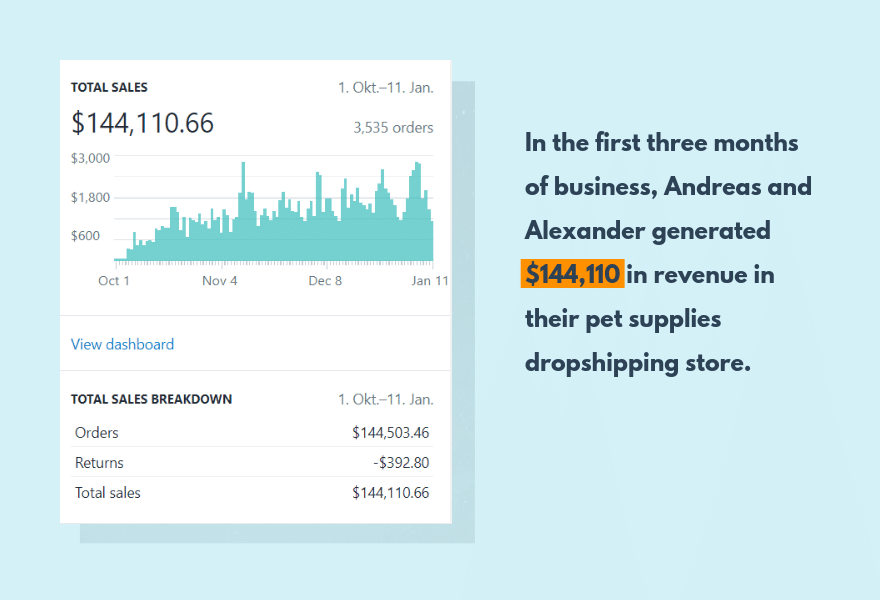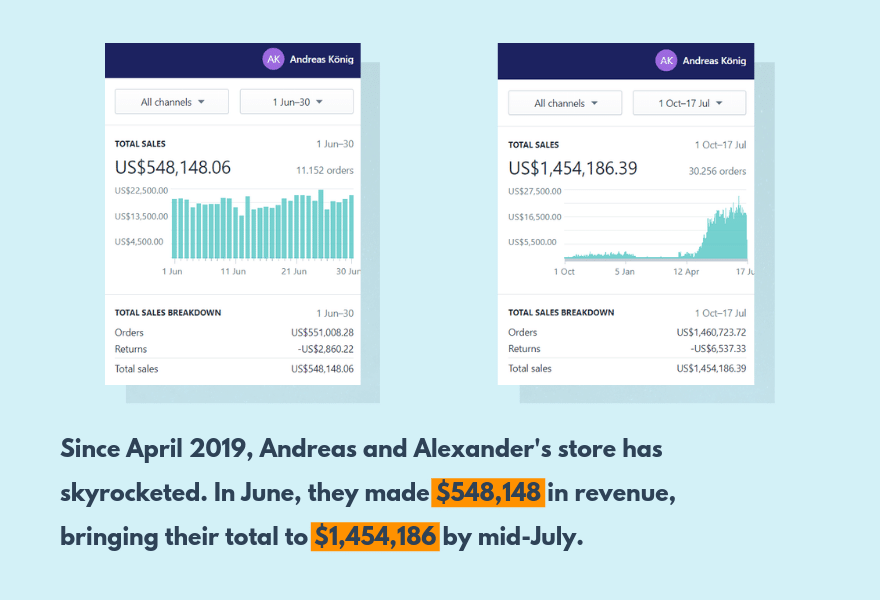You might recognize Andreas and Alexander. They’re the two friends from Austria who decided to grow a dropshipping business together. We featured the beginnings of their story on the blog, and they even appeared on our YouTube channel recommending products (you’ll find the interview below).
Like so many others, the road to success for Andreas and Alexander wasn’t smooth. It was full of failures and self-doubt, and long days and late nights spent grinding, trying to get their business off the ground.
But after two failed stores, they finally found a formula that worked with their pet products business. When we left them last time, they were just over three months into running their pet store and were averaging $41,000 in revenue each month.

In the six months since, a lot has changed for Andreas and Alexander. I called them up to see what’s been happening.
Since our last chat, the pair have been focused on scaling their business aggressively, and they’ve experienced all the growing pains that go along with that. As we spoke, they opened up about the realities of what happens when you scale a dropshipping business, including everything that could (and did) go wrong.
Here’s what they had to say.



Make Sure Your Suppliers Can Scale With You
As you grow your business and begin to process a larger volume of orders, it’s crucial to make sure that your suppliers can keep up. Andreas and Alexander had to learn this the hard way.
Since early 2019, Andreas had been on a single mission – to find a new supplier who could develop a custom product for them. They sensed that this new product had the potential to go viral, and they needed to find a supplier who could not only develop the product for them, but who could also take on the responsibility of fulfilling a huge volume of orders.
→ Click Here to Launch Your Online Business with Shopify
After a long search, they came across a supplier who seemed like the perfect match. Excited, they launched the new product in their store and began to push it hard with advertising.
Their instincts were right, the product took off immediately. As the sales started to pour in, they relied heavily on their new supplier to keep up with the demand and fulfill orders correctly.
At first it all seemed to be going along smoothly. But then as their customers’ orders began to arrive, suddenly everything seemed to fall apart.
“We had a lot of problems with this supplier because he made a lot of mistakes,” says Andreas.
“They really mixed up hundreds of orders,” adds Alexander. “They got everything wrong. Every person got the wrong size, the wrong color, the wrong custom printing.”
The supplier was also slow shipping orders, which meant that by the time customers began to receive their items and they realized what was going wrong, Andreas and Alexander had already processed hundreds of orders through this supplier.
That meant hundreds of returns and exchanges, and hours upon hours trawling their way through emails from upset customers.
“In the future, I would never go to a new supplier and order such a high amount at the beginning. I would order small amounts like 10-50 pieces, use them for one month, and if I see it is working. Then I would order higher amounts.”
Since then, after weeks of searching and time spent testing the supplier’s abilities, they’ve found another supplier who is able to handle the 400+ orders per day they’re currently receiving.
PayPal Can Be Your Friend or Your Worst Enemy
After finding a new supplier who could handle the larger volumes, Andreas and Alexander were keen to scale their business as quickly as possible. They’d found a product that was resonating with their audience, and their ads were continuing to perform well.
They began scaling their ad spend, and were soon spending more than $7,000 per day on ads. With so much money pouring in and out of their account, the increased activity triggered suspicion from the folks over at PayPal.
The money in their account was blocked.
PayPal had frozen the funds in their account until they were able to verify that the increased activity was genuine, and not someone running an elaborate scam. PayPal demanded to see documentation verifying their business and refused to unlock the funds until they received them.
With over 50 percent of their sales coming through PayPal, that meant that a huge chunk of the cashflow they were counting on was totally inaccessible.
They immediately got on the phone to try to provide the documentation that PayPal needed. Once the documentation was received, the funds were released. The pair breathed a sigh of relief and began to scale up their advertising spend again.
And then… blocked again.
It happened four times in total, resulting in one of them scrambling to sort out the situation so they could continue to grow.
Why does PayPal block the funds someone’s account?
PayPal is responsible for protecting their customers from fraud. This means that each time there is a rapid increase in the amount of money going in and out of someone’s account, it flicks the switch in PayPal’s internal systems which limits access to the funds in the account.
Although the situation resulted in some hair-pulling stress, they understand now that they should have alerted PayPal to their plans to scale earlier.
“You have to speak with PayPal and your bank accounts and verify everything with them,” Alexander says. “You have to tell them, ‘Okay, turnover will increase. Do you need any documents from me?’ This will help so that they don’t block you so fast.”
| NOTE: If you’re concerned about being blocked by PayPal, try looking into some alternative payment gateways. Shopify has put together a comprehensive list of payment gateways available in each country. |
You’re Going to Need a Team, so Start Building One Now
When they started, Alexander wore the customer service hat. He sacrificed many hours of sleep to ensure he was available to answer customer service calls and emails at any time of day.
But as the business began to scale, it became clear that he wouldn’t be able to handle it all by himself.
“Now we have around more than 200 tickets every day,” says Andreas. “So we switched to a customer service ticket system, so we can handle a lot of tickets. At the moment we have three to four agents helping us with the tickets.”
They’ve built a team of virtual assistants based in the Philippines, and have even hired a manager to manage their team of assistants. After spending some time training up the customer agents, they’ve been able to step back and focus on the bigger tasks needed for scaling.
“We have created groups on Skype and Facebook and the supplier and our customer agents are communicating in that group by themselves. So we just are also in the group, if there are questions, but they send messages by themselves.”
They agree that It’s crucial to get this team set up before you start to scale, so you’ll be prepared to handle the tidal wave of extra customer support requests.
“Customer support is very important, because if you scale and you have no customer support team, you will get hundreds of emails and will not be able to manage them.”
“It’s important that this team is set up and that they know already what to do, then you can scale,” says Alexander.

Video Advertising Works All the Way Through the Funnel
Counterintuitive to what some people might think, Andreas and Alexander have shown that video advertising can work to convert users all the way through the sales funnel.
Video advertisements are total dynamite at reaching a lot of people and getting them to engage with your content. There’s proof of that.
But this ad format has traditionally been thrown aside as customers progress down the funnel, in favor of more straightforward formats like link posts or carousels.
But through hundreds of different versions of ads and thousands of dollars spent testing them, Andreas and Alexander have found that the power of videos ads continue to show itself throughout the whole funnel.
Want them to engage with your content? Video ads can do that.
Want them to click through to your store? Video ads can do that.
Want them to add to cart? Or to buy your product? Video ads can do that too.
Andreas and Alexander have even used the same video repeatedly throughout all the variations of their ads.
They’ll use the same video for targeting cold traffic as they do with remarketed ads, but they’ll tweak the copy and the discount amount offered to encourage users to take the final steps towards purchase.
There’s no stock footage or supplier-made videos here, though. Their winning video ad is completely original content. They shot and edited the ad themselves, and even convinced Alexander’s mother to be their star.
Thanks to the success of their ads, the video has now been viewed more times than they could have imagined.
“Now millions and millions of people know his mother,” laughs Andreas.
Campaign Budget Optimization Changes Everything
In case you haven’t heard the news, Facebook is about to make some big changes to their advertising platform.
In September 2019, they’re bringing in Campaign Budget Optimization (CBO). In other words, when you create advertising campaigns on Facebook, all your different audiences and ads will be intelligently optimized to give the most budget to the ads and audiences that are performing the best.
With Facebook tightening its grip on one of the features that allowed marketers to optimize their ad strategy down the smallest detail, you might be wondering if this change will have a positive or negative impact on your advertising results.
For Andreas and Alexander, it’s proven to be a massive win.
Although the changes aren’t officially coming in until September, they decided to try out the new method early.
“For us it has been working very well because we already had a very strong Facebook pixel.”
“We had thousands and thousands of pieces of customer data. So when the pixel is already strong and you have a lot of data and you work with CBO, then you can really make so many sales,” says Andreas.
| NOTE: Campaign Budget Optimization is going to work particularly well if you’ve already fed your Facebook pixel with a lot of data about your audience. Now more than ever, you’ll have to make sure you spend time seasoning your pixel. You can do this either by committing a lump of money to run ads and “buy” the data, or look at some free traffic methods to drive people to your store. |
But once you’ve got the data built up, you’re going to be able to scale easier than ever before.
“We can make more sales than the supplier can handle at the moment,” laughs Andreas. “So our supplier said, ‘Hey, please go a little bit slower. We cannot do more!’”

Conclusion
Despite the growing pains, Andreas and Alexander’s business has continued to go up and up. In June 2019, they hit an important milestone – $500,000 in revenue in one month.
The numbers are staggering, and the pair are blown away by how far they’ve come in the nine months since they launched their pet business.
They hope their success serves as a reminder that the opportunities that are waiting out there are greater than you might think.
“We think our story can be an inspiration for all these new dropshippers,” says Alexander. “That everything is possible, because our lives have really changed and it’s been great.”


